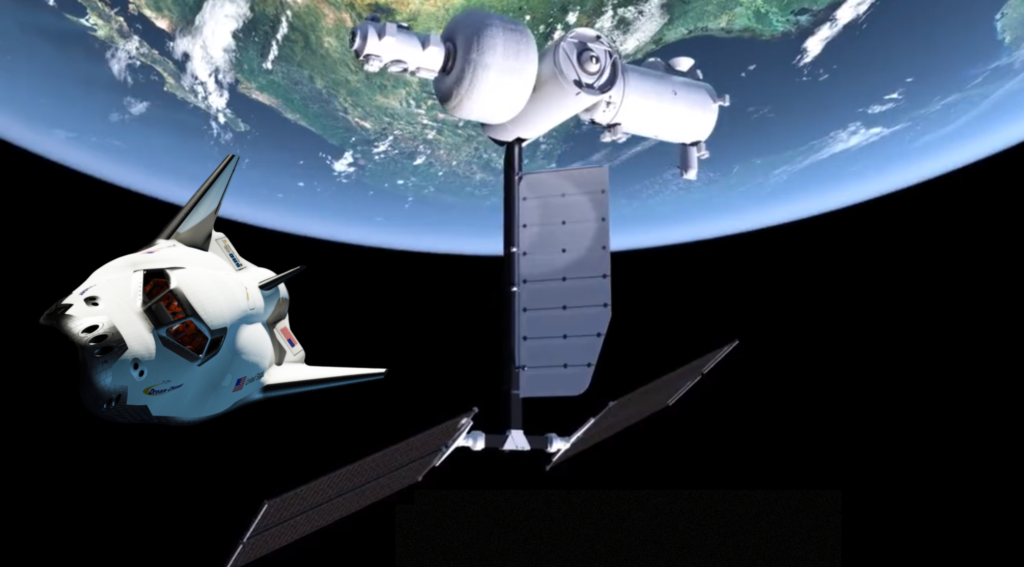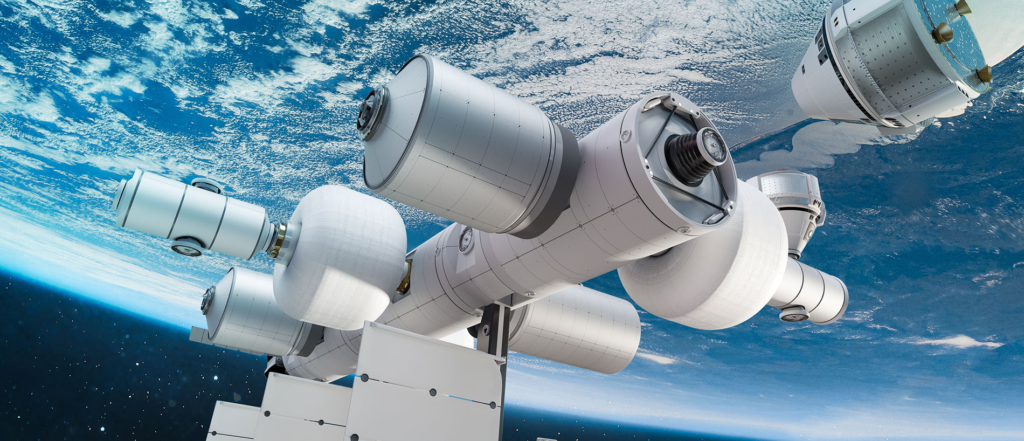
Is Sierra Space & Blue Origin Making Progress On Orbital Reef?
For decades now, the International Space Station has been orbiting our planet and providing a completely unique environment for scientists and agencies around the world. However, as time goes on, not only is the ISS getting older, but companies such as Sierra Space and Blue Origin continue to work on future space destinations including Orbital Reef.
This being said, with the one year anniversary of NASA picking these companies approaching, it begs the question of what progress has been made. Especially considering that both Sierra Space and Blue Origin already are busy with a host of different projects. In order for Orbital Reef to be a success, everyone involved needs to contribute a lot of time and money.
Currently, valuable projects such as Dream Chaser and New Glenn are being worked on, expected to be the backbone of this station’s future. In addition, Sierra Space recently signed a new contract with a space collaborative with the hopes of making Orbital Reef a reality. Here I will go more in-depth into what progress has been made on this station, recent updates, what to expect in the future, and more.
Almost 1 Year Since NASA’s Contract

Almost 1 year ago, on December 4th, 2021, Orbital Reef was selected by NASA for a funded Space Act Agreement for collaboration to design a commercially owned and operated space station in low Earth orbit (LEO). NASA’s Commercial LEO Development program aims to shift NASA’s research and exploration activities in LEO to commercial space stations, helping stimulate a growing space economy before the International Space Station is retired. One of the unique aspects of this project is the number of different contributors. While Sierra Space and Blue Origin are the two main companies, the Orbital Reef team also includes Boeing, Redwire Space, Genesis Engineering Solutions, and Arizona State University.
All of which have specific strengths and intended projects that will eventually contribute to the commercial space station. With it being almost a year since the project was selected by NASA, we can take a closer look at these different companies’ contributions and how progress is coming along. Starting with Boeing, which is intended to lead the development of the station’s operations and maintenance and science module, and provide the Starliner crew capsule. Unfortunately, Starliner has had quite a few complications and delays over the past few years. During its first official orbital mission in late 2019, the capsule successfully reached orbit but was unable to rendezvous with ISS. Not long ago during the OFT 2 mission, Starliner was able to dock with the ISS. However, more delays have pushed the third mission back even further. In terms of its application to Orbital Reef, because the station isn’t expected to be ready until late in this decade, Starliner has plenty of time to prepare for human missions. Not to mention, if this spacecraft were to have problems and not be available in the future, there are other options for transporting humans to and from the station.
Next is Blue Origin which leads the development of the station’s infrastructure, large-diameter metal modules, last-mile space tug, and partially reusable heavy-lift New Glenn launch system. In this case, Blue Origin is responsible for some of the main core services and infrastructure for this station. Unlike Boeing’s contribution, if these components are delayed, there is not much that can be done in terms of replacements. New Glenn is one of the most important out of these contributions and is expected to carry a majority of the station into orbit. While this rocket has faced very consistent delays, and has by no means been the fastest, Blue Origin recently reached a significant milestone. Just two weeks ago they delivered ULA with the first shipset for Vulcan. These are the first BE-4 engines expected to fly and are a good sign for the company. This being said, Blue Origin will need these engines to not only operate perfectly, but the company has to increase the production and testing significantly if they want to provide future Vulcan and New Glenn rockets.
Finally, there is Sierra Space, which leads development of the LIFE (Large Integrated Flexible Environment), small-diameter metal node modules, and Dream Chaser spaceplane for crew and cargo transportation with runway landing anywhere in the world. Recently we watched some pressure tests of a LIFE module test article. Sierra Space reported that it performed better than expected and is continuing to work on the project. As for Dream Chaser, right now the test article Tenacity is getting more than two thousand hand-cut thermal tiles attached to its structure. This process has been in the works for more than a month now as Sierra Space continues to work on the project. With the first orbital test flight scheduled in late 2023, Dream Chaser is making decent progress.
Updates & Overview

Now that we know more about the main companies involved and how each of their contributions is coming along, we can take a closer look at some additional updates and the project itself. As of right now, Orbital Reef is scheduled to be operational around 2027. Just 3 days ago, however, the Keystone Space Collaborative, a nonprofit organization leading the expansion of space industry business and talent in Ohio, Pennsylvania, and West Virginia, and Sierra Space, signed a Memorandum of Understanding (MOU) that supports the development of Orbital Reef. The MOU also supports joint business opportunities between the Keystone Space Collaborative and Sierra Space, aligning with the Collaborative’s mission to advance the space economy in these three states.
The partnership ultimately aims to inspire a broader interest in the commercial LEO economy and in microgravity research. The goal is to capitalize on Sierra Space’s access to platforms in space and the Keystone Space Collaborative’s growing network of customers who realize the benefit of these platforms to develop a pipeline of research and technology in commercial LEO for all types of organizations in the region. Furthermore, Sierra Space and the Keystone Space Collaborative believe their combined efforts offer great opportunities in initial research and technical payloads for use in commercial space stations such as Orbital Reef.
In addition to this new partnership, earlier this year Orbital Reef completed its SRR and SDR. Specifically, starting in April, the team completed its Systems Requirements Review (SRR) in just three months. The SRR is an important program milestone marking the baselining of the requirements for the mission and design of Orbital Reef. The SRR reviewed Orbital Reef specifications to ensure they reflect the current knowledge of the mission and market requirements to serve as a stable baseline to proceed with development. NASA awarded the agreement in December 2021 to shift NASA’s research and exploration activities in LEO to commercial space stations and help stimulate a growing space economy. The review assessed Orbital Reef’s ability to meet safety and mission requirements and evaluated the technical readiness of the design, the concept of operations, the feasibility of project development plans, and planned verification activities. Representatives from Blue Origin, Sierra Space, team members, and NASA participated in the review, which was conducted virtually.
Next just a few months later in August, they announced they had completed the System Definition Review (SDR) with NASA. The SDR is an additional milestone to establish the functional baseline for Orbital Reef. It demonstrates to NASA that the space station design is feasible and achievable while validating that the Orbital Reef system is on-track to proceed into the design phase. The SDR included an extensive review to ensure that the proposed Orbital Reef architecture is responsive to the functional and performance requirements; it examined the proposed system architecture and the flowdown to all functional elements of the Orbital Reef system. The successful SDR supported NASA’s decision to further develop the system architecture and design. Representatives from Blue Origin, Sierra Space, team members, and NASA participated in the review, conducted between mid-June and mid-July to allow in-depth review of documentation and feedback to the team.
“We are on the doorstep of the most profound industrial revolution in human history. An industrial revolution marked by the transition from the last 60 years of space exploration to a future where humanity extends our factories and cities into space. It isn’t solely about tourism – it is about unlocking the next great discoveries using the microgravity factories that we will build just 250 miles above the Earth’s surface,” said Tom Vice, CEO of Sierra Space. “The microgravity factories and services provided by Orbital Reef have the potential to revolutionize every industry and become a major growth contributor to the U.S. and world economies.” “This SDR moves Orbital Reef forward,” said Brent Sherwood, Senior Vice President of Advanced Development Programs at Blue Origin. “We are meeting the needs of both the commercial marketplace and NASA’s requirements. Orbital Reef will change the game for human space flight in Earth orbit.”
Conclusion
Orbital Reef is an ambitious project that relies on a host of different companies each contributing specific infrastructure and or services. In the almost year since NASA selected Orbital Reef, progress has been made on some of the necessary projects. We will have to wait and see how it progresses and the impact it has on the space industry.
